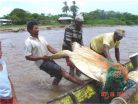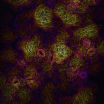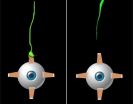(Press-News.org) This news release is available in German.
The only linguistic data available for Carabayo, a language spoken by an indigenous group that lives in voluntary isolation, is a set of about 50 words. This list was compiled in 1969 during a brief encounter with one Carabayo family. Frank Seifart of the Max Planck Institute for Evolutionary Anthropology in Leipzig, Germany, and Juan Alvaro Echeverri of the Universidad Nacional de Colombia in Leticia, Colombia, have now analysed this historical data set and compared it with various languages (once) spoken in the region. The analysis showed that Carabayo shares a number of similarities with the extinct language Yurí and with Tikuna, a language still spoken in the region nowadays. From the results of their study the researchers conclude that the Carabayo – directly or indirectly – descend from the Yurí people whose languages and customs were described by explorers in the 19th century, before they took up voluntary isolation.
According to Survival International there are around 100 uncontacted indigenous groups worldwide, a few dozen of them living in the Amazonian rainforest. One of them, the Carabayo, lives in voluntary isolation in the remote upper Puré River region in the Colombian Amazon rainforest. The most recent evidence of the Carabayo's persistence are aerial photographs of their roundhouses taken in 2010 which were published in the book Cariba Malo by the Colombian researcher Roberto Franco.
In early 1969, a military commission on a rescue mission, made violent contact with the Carabayo and took one family hostage. "While this family was held captive, speakers of all living languages of the region tried to communicate with them but failed", says Frank Seifart of the Max Planck Institute for Evolutionary Anthropology. "Researchers thus concluded that Carabayo was not related to any living language in the region."
Frank Seifart and Juan Alvaro Echeverri have now compared the Carabayo words with historical wordlists of extinct languages of the region that were documented by explorers in the 19th century. "Our comparison of the Carabayo data revealed that a number of Carabayo forms match corresponding Yurí elements, but none match forms of the other languages", says Seifart. The researchers identified four Carabayo forms – a first person singular prefix, and the words for 'warm', 'boy' and 'father' – to match corresponding Yurí forms well. "The strongest evidence for a link between Carabayo and Yurí comes from the first person singular prefix", says Seifart. "Personal pronouns are known to be especially resistant to borrowing which is why their similarity indicates a genealogical link, rather than language contact."
The researchers then compared Carabayo to languages spoken in the Colombian Amazon area nowadays and found a number of very good matches between Carabayo and Tikuna, but not with any other living language of the region. "What adds credibility to these matches is that they exhibit regular sound correspondences: For instance Carabayo g corresponds to Tikuna ng in a number of words. That can hardly be a coincidence", says Seifart. The researchers conclude that Yurí, Carabayo and Tikuna are genealogically related, with Carabayo somewhere in the middle between Yurí and Tikuna, but probably closer to Yurí. "The ease with which Carabayo data could be interpreted by a native Tikuna speaker additionally suggests that these languages are relatively closely related and may even form – or have formed in the past – a dialect continuum", says Seifart.
INFORMATION:
Original publication:
Frank Seifart, Juan Alvaro Echeverri
Evidence for the identification of Carabayo, the language of an uncontacted people of the Colombian Amazon, as belonging to the Tikuna-Yurí linguistic family
PLOS ONE, 16 April 2014
Family ties in the language jungle
Max Planck researchers reveal relationships between rare languages in the Colombian Amazon
2014-04-17
ELSE PRESS RELEASES FROM THIS DATE:
High disease load reduces mortality of children
2014-04-17
This news release is available in German. Children who have been conceived during a severe epidemic are more resistant against other pathogens later in life. For the first time this has been proved by researchers at the Max Planck Institute for Demographic Research (MPIDR) in Rostock, Germany, for the 18th century epidemics of measles and smallpox in the Canadian province of Québec. Children who were conceived during the wave of measles in 1714 and 1715 died significantly less often from smallpox 15 years later than children who had been conceived before the measles ...
Declining catch rates in Caribbean green turtle fishery may be result of overfishing
2014-04-17
A 20-year assessment of Nicaragua's legal, artisanal green sea turtle fishery has uncovered a stark reality: greatly reduced overall catch rates of turtles in what may have become an unsustainable take, according to conservation scientists from the Wildlife Conservation Society and University of Florida.
During the research period, conservation scientists estimated that more than 170,000 green turtles were killed between 1991 and 2011, with catch rates peaking in 1997 and 2002 and declining steeply after 2008, likely resulting from over-fishing. The trend in catch rates, ...
In old age, lack of emotion and interest may signal your brain is shrinking
2014-04-16
MINNEAPOLIS – Older people who have apathy but not depression may have smaller brain volumes than those without apathy, according to a new study published in the April 16, 2014, online issue of Neurology®, the medical journal of the American Academy of Neurology. Apathy is a lack of interest or emotion.
"Just as signs of memory loss may signal brain changes related to brain disease, apathy may indicate underlying changes," said Lenore J. Launer, PhD, with the National Institute on Aging at the National Institutes of Health (NIH) in Bethesda, MD, and a member of the American ...
Dermatologists with access to sample drugs write costlier prescriptions, Stanford study finds
2014-04-16
STANFORD, Calif. — Dermatologists with access to free drug samples are more likely than those without access to samples to write prescriptions for drugs that are more expensive, according to a study by researchers at the Stanford University School of Medicine.
Although studies have shown that most physicians do not believe that the availability of free samples affects their behavior or recommendations for patients, the researchers found that the average retail cost of the prescriptions written by dermatologists with access to samples are about twice the cost of prescriptions ...
Free drug samples can change prescribing habits of dermatologists
2014-04-16
The availability of free medication samples in dermatology offices appears to change prescribing practices for acne, a common condition for which free samples are often available.
Free drug samples provided by pharmaceutical companies are widely available in dermatology practices.
The authors investigated prescribing practices for acne vulgaris and rosacea. Data for the study were obtained from a nationally representative sample of dermatologists in the National Disease and Therapeutic Index (NDTI), a survey of office-based U.S. physicians, and from an academic medical ...
Atypical brain connectivity associated with autism spectrum disorder
2014-04-16
Autism spectrum disorder (ASD) in adolescents appears to be associated with atypical connectivity in the brain involving the systems that help people infer what others are thinking and understand the meaning of others' actions and emotions.
The ability to navigate and thrive in complex social systems is commonly impaired in ASD, a neurodevelopmental disorder affecting as many as 1 in 88 children.
The authors used functional magnetic resonance imaging to investigate connectivity in two brain networks involved in social processing: theory of mind (ToM, otherwise known ...
For cells, internal stress leads to unique shapes
2014-04-16
From far away, the top of a leaf looks like one seamless surface; however, up close, that smooth exterior is actually made up of a patchwork of cells in a variety of shapes and sizes. Interested in how these cells individually take on their own unique forms, Caltech biologist Elliot Meyerowitz, postdoctoral scholar Arun Sampathkumar, and colleagues sought to pinpoint the shape-controlling factors in pavement cells, which are puzzle-piece-shaped epithelial cells found on the leaves of flowering plants. They found that these unusual shapes were the cell's response to mechanical ...
Researchers track down cause of eye mobility disorder
2014-04-16
Imagine you cannot move your eyes up, and you cannot lift your upper eyelid. You walk through life with your head tilted upward so that your eyes look straight when they are rolled down in the eye socket. Obviously, such a condition should be corrected to allow people a normal position of their head. In order to correct this condition, one would need to understand why this happens.
In a paper published in the April 16 print issue of the journal Neuron, University of Iowa researchers Bernd Fritzsch and Jeremy Duncan and their colleagues at Harvard Medical School, along ...
Scientists observe quantum superconductor-metal transition and superconducting glass
2014-04-16
The article "Collapse of superconductivity in a hybrid tin–grapheme Josephson junction array'" (authors: Zheng Han, Adrien Allain, Hadi Arjmandi-Tash,Konstantin Tikhonov, Mikhail Feigelman, Benjamin Sacépé,Vincent Bouchiat, published in Nature Physics on March 30, 2014, DOI:10.1038/NPHYS2929) presents the results of the first experimental study of the graphene-based quantum phase transition of the "superconductor-to-metal" type, i.e. transformation of the system's ground state from superconducting to metallic, upon changing the electron concentration in graphene sheet.
The ...
Stanford scientists develop 'playbook' for reverse engineering tissue
2014-04-16
STANFORD, Calif. — Consider the marvel of the embryo. It begins as a glob of identical cells that change shape and function as they multiply to become the cells of our lungs, muscles, nerves and all the other specialized tissues of the body.
Now, in a feat of reverse tissue engineering, Stanford University researchers have begun to unravel the complex genetic coding that allows embryonic cells to proliferate and transform into all of the specialized cells that perform myriad biological tasks.
A team of interdisciplinary researchers took lung cells from the embryos of ...
LAST 30 PRESS RELEASES:
Personalised “cocktails” of antibiotics, probiotics and prebiotics hold great promise in treating a common form of irritable bowel syndrome, pilot study finds
Experts developing immune-enhancing therapies to target tuberculosis
Making transfusion-transmitted malaria in Europe a thing of the past
Experts developing way to harness Nobel Prize winning CRISPR technology to deal with antimicrobial resistance (AMR)
CRISPR is promising to tackle antimicrobial resistance, but remember bacteria can fight back
Ancient Maya blessed their ballcourts
Curran named Fellow of SAE, ASME
Computer scientists unveil novel attacks on cybersecurity
Florida International University graduate student selected for inaugural IDEA2 public policy fellowship
Gene linked to epilepsy, autism decoded in new study
OHSU study finds big jump in addiction treatment at community health clinics
Location, location, location
Getting dynamic information from static snapshots
Food insecurity is significant among inhabitants of the region affected by the Belo Monte dam in Brazil
The Society of Thoracic Surgeons launches new valve surgery risk calculators
Component of keto diet plus immunotherapy may reduce prostate cancer
New circuit boards can be repeatedly recycled
Blood test finds knee osteoarthritis up to eight years before it appears on x-rays
April research news from the Ecological Society of America
Antimicrobial resistance crisis: “Antibiotics are not magic bullets”
Florida dolphin found with highly pathogenic avian flu: Report
Barcodes expand range of high-resolution sensor
DOE Under Secretary for Science and Innovation visits Jefferson Lab
Research expo highlights student and faculty creativity
Imaging technique shows new details of peptide structures
MD Anderson and RUSH unveil RUSH MD Anderson Cancer Center
Tomography-based digital twins of Nd-Fe-b magnets
People with rare longevity mutation may also be protected from cardiovascular disease
Mobile device location data is already used by private companies, so why not for studying human-wildlife interactions, scientists ask
Test reveals mice think like babies
[Press-News.org] Family ties in the language jungleMax Planck researchers reveal relationships between rare languages in the Colombian Amazon


